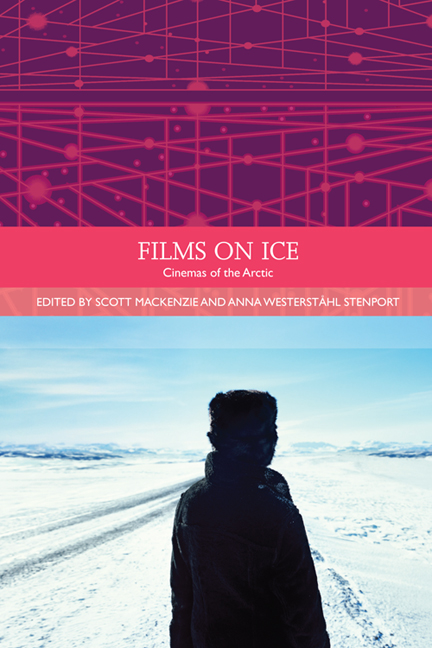Book contents
- Frontmatter
- Contents
- List of Illustrations
- Acknowledgements
- Traditions in World Cinema
- Introduction: What are Arctic Cinemas?
- PART I GLOBAL INDIGENEITY
- PART II HOLLYWOOD HEGEMONY
- 8 Fact and Fiction in ‘Northerns’ and Early ‘Arctic Films’
- 9 California's Yukon as Comic Space
- 10 ‘See the Crashing Masses of White Death…’: Greenland, Germany and the Sublime in the ‘Bergfilm’ SOS Eisberg
- 11 The Threat of the Thaw: The Cold War on the Screen
- 12 Hollywood Does Iceland: Authenticity, Genericity and the Picturesque
- 13 White on White: Twenty-First-Century Norwegian Horror Films Negotiate Masculinist Arctic Imaginaries
- PART III ETHNOGRAPHY AND THE DOCUMENTARY DILEMMA
- PART IV MYTHS AND MODES OF EXPLORATION
- Notes on the Contributors
- Index
9 - California's Yukon as Comic Space
from PART II - HOLLYWOOD HEGEMONY
Published online by Cambridge University Press: 05 September 2016
- Frontmatter
- Contents
- List of Illustrations
- Acknowledgements
- Traditions in World Cinema
- Introduction: What are Arctic Cinemas?
- PART I GLOBAL INDIGENEITY
- PART II HOLLYWOOD HEGEMONY
- 8 Fact and Fiction in ‘Northerns’ and Early ‘Arctic Films’
- 9 California's Yukon as Comic Space
- 10 ‘See the Crashing Masses of White Death…’: Greenland, Germany and the Sublime in the ‘Bergfilm’ SOS Eisberg
- 11 The Threat of the Thaw: The Cold War on the Screen
- 12 Hollywood Does Iceland: Authenticity, Genericity and the Picturesque
- 13 White on White: Twenty-First-Century Norwegian Horror Films Negotiate Masculinist Arctic Imaginaries
- PART III ETHNOGRAPHY AND THE DOCUMENTARY DILEMMA
- PART IV MYTHS AND MODES OF EXPLORATION
- Notes on the Contributors
- Index
Summary
This chapter concerns the ‘snow line’ of silent comedy in 1920s Hollywood cinema: the line that separates the use of natural snow from its artificial substitutes. At stake is a literal question of climate control, one that resonates not only with Hollywood's developing compromises between studio production and location shooting in the 1920s, but also with more general cultural trends towards the domination of weather through technology. Climate control was actually a wide-ranging American project of the first decades of the twentieth century; the Hollywood case simply plays out the film technology version thereof. This essay turns to comic variations of the Hollywood ‘snow picture’ in order to show their overt treatment of a conceptual issue more deeply buried in the snowdrifts of the usual dramas of the Frozen North, namely that there were limits to Hollywood's dual fantasy of geographic access and climatological control. And it all comes down to melting snow.
The prerequisite genre for these comedies was known variously in the 1910s and 1920s as the ‘snow picture’, the Yukon film, the Mountie film, or even the ‘pure white drama’, as one unnamed journalist put it when describing the genre target of Buster Keaton's parody The Frozen North in 1922 (Chamberlain n.d.). That group included films by William S. Hart and others, films that were essentially Westerns transposed for the sake of narrative variation to the setting of the Far North. The four comic films chosen here, however, were later inversions of the Yukon film at the point in the mid-1920s when the northern formula had become cliché. As one reviewer of The Frozen North put it, this was a film that ‘will reinvigorate all those who have suffered from the “Northern” picture’ (‘First runs’ 1923: 818). In addition to the Keaton film, this analysis deals with three others: two are closely related films made by Mack Sennett with cross-eyed comic actor Ben Turpin (Homemade Movies from 1922 and Yukon Jake from 1924); the third and best known is Charlie Chaplin's The Gold Rush from 1925.
- Type
- Chapter
- Information
- Films on IceCinemas of the Arctic, pp. 134 - 147Publisher: Edinburgh University PressPrint publication year: 2014



